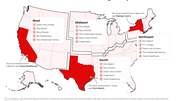Staffing
Fixing the Leaky Bucket: How fast casuals should rethink retention
Rahkeem Morris, founder and CEO of HourWork, shares results from an exit survey of over 8,000 fast-food restaurants nationwide that found that management was critical to an employee's experience, even more so than schedule and pay.

February 14, 2023
Over the past three years, labor, hiring and the culture surrounding work has shifted dramatically. With labor shortages and changing attitudes towards work, it's an employee market, especially in the fast casual restaurant industry. Owners and operators are faced with rising employee standards that they are forced to meet in order to stay competitive in the market.
Franchise owners are susceptible to what I call "the leaky-bucket problem." They are always in hiring mode (water coming into the bucket), while at the same time, there is an understandable level of employee turnover (water leaking out of the bucket). The problem is that in today's labor market, where labor shortages are slowing hiring efforts and increased job opportunities are increasing turnover, the flow of water entering the bucket has slowed while the leak has gotten bigger.
On average, it costs $1,500 to hire and train a new employee, and fast casual employees generally take about six months to be fully trained. However, the typical employee leaves after just 75 days. When this cost is combined with the hit to customer experience and sales that results from being short-staffed, it's clear that retention needs to be just as much a focus as recruiting is.
In order to right-size this problem and ensure that recruitment is not undermined by turnover, franchisees need to match recruitment with retention efforts — continuing to fill from the top while slowing the leak from the bottom. To do so, it's important for franchise owners to understand their employees' needs, concerns and desires in order to not only stop them from leaving but to keep them happy and engaged.
In a recent year-end report from HourWork that compiled exit survey data from more than 8,000 fast-food restaurants nationwide, we asked about workplace satisfaction. The findings showed that management was critical to an employee's experience, even more so than schedule and pay. In exit surveys, employees mentioned "manager" nearly twice as often as "wage," proving that good management is even more important than good pay.
So how can franchise owners address this? Increasing communication between employees and managers can be the simplest, most effective way to retain staff. In fact, employees are five times more likely to quit due to miscommunication in their first 90 days, so focusing on establishing those channels early and often can lead to big improvements.
Facilitating this two-way communication helps employees to feel heard, engaged and valued. Additionally, showing interest in not only their work but also their lives outside of the restaurant helps to create stronger interpersonal connections and a sense of belonging in the workplace.
When owners prioritize communication, actively listening and quickly addressing feedback, they will see retention, engagement and productivity increase.
Once employees are being heard, managers and owners can work together to address major workplace concerns top of mind to their teams. Schedule and pay remain top priorities for hourly workers, especially during the onboarding process within the first 14 days of employment, and being able to provide feedback and answers regarding those topics can go a long way to decreasing an employee's likelihood to quit.
As franchise owners take a look at the year ahead and consider their business strategies, retention should be a top priority alongside recruitment. Those who understand the value of retention and take the necessary steps toward implementing strategies to keep employees within their workplace will come out as winners in the ongoing battle for talent. By fixing the leaky-bucket problem, owners will get their restaurants to full productivity and ultimately create a more positive working environment with engaged employees.












